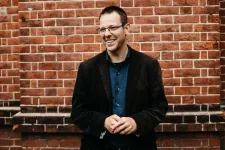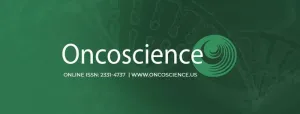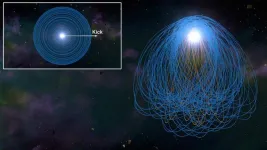(Press-News.org) Record-setting storms in 2023 filled California’s major reservoirs to the brim, providing some relief in a decades-long drought, but how much of that record rain trickled underground?
Shujuan Mao of Stanford University and her colleagues used a surprising technique to answer this question for the greater Los Angeles metropolitan area. They analyzed changes in the velocity of seismic waves traveling through the LA basin, tracking these changes in space and time between January and October 2023.
As Mao reported at the Seismological Society of America (SSA)’s 2024 Annual Meeting, their study found that groundwater levels almost completely recovered at very shallow depths—about 50 meters below the surface. However, only about 25% of the groundwater lost over the past two decades was replenished at about 300 meters and deeper, likely because it is more challenging for stormwater to percolate into deeper layers of the earth.
“That means that a single epic year of storms is not enough to restore the groundwater depletion accumulated over the recent droughts. It takes many more wet years for the deep aquifer to fully recover,” Mao said.
Groundwater contributes more than 60% of the water supply used in California during drought conditions, she noted.
Mao and her colleagues are pioneering the use of seismic data to understand groundwater levels in the Los Angeles basin, as a complement to other methods used to measure groundwater levels. The most traditional method involves digging wells, which is expensive and only offers a “point scale measurement,” Mao explained. “You don’t know what the level is between two wells, or in other aquifer layers shallower or deeper relative to your well.”
More recently, researchers have been using satellite measurements to detect small changes in Earth’s surface deformation or gravity field, which works well to infer changes in groundwater storage over time and area. “These surface measurements couldn’t tell us what’s happening at different depths,” said Mao, "but that’s where we as seismologists can help.”
With data from 65 broadband seismographs in the Southern California Seismic Network, the researchers looked at changes in the propagation speed of seismic waves. The data they used are the “background” seismic vibrations generated by the oceans, winds, and human activity—not the seismic waves associated with earthquakes.
“These background seismic vibrations are continuous, which allow us to measure and monitor the seismic velocity changes continuously,” Mao said.
Seismic wave speed varies with the mechanical state of materials that the waves are passing through. When the groundwater level increases, the pressure in the porous space among rocks increases, and the seismic waves propagate slower through this porous rock.
The researchers found that their estimates of groundwater storage calculated from seismic velocity change compared well with groundwater storage measurements from well and satellite data.
The researchers also found prominent aquifer replenishment in San Gabriel Valley and Raymond Basin, likely due to surface or subsurface flows from the San Gabriel mountains.
The combination of a dense seismic network and a pressing water shortage made Los Angeles “an ideal place to showcase how existing seismic data can contribute to the monitoring, understanding, and management of groundwater aquifers,” said Mao.
Seismic data would likely be integrated with many types of measurements to produce the comprehensive picture of groundwater dynamics needed to manage the valuable resource in a data-informed and sustainable manner, she added.
Mao, who will be an assistant professor at The University of Texas at Austin in August, said she will apply seismic techniques in Austin to monitor how aquifers in that region respond to artificial recharge operations.
END
Seismic waves used to track LA’s groundwater recharge after record wet winter
2024-05-04
ELSE PRESS RELEASES FROM THIS DATE:
When injecting pure spin into chiral materials, direction matters
2024-05-03
Researchers from North Carolina State University and the University of Pittsburgh studied how the spin information of an electron, called a pure spin current, moves through chiral materials. They found that the direction in which the spins are injected into chiral materials affects their ability to pass through them. These chiral “gateways” could be used to design energy-efficient spintronic devices for data storage, communication and computing.
Spintronic devices harness the spin of an electron, rather than its charge, to create current and move information through electronic devices.
“One of the goals in spintronics ...
New quantum sensing scheme could lead to enhanced high-precision nanoscopic techniques
2024-05-03
Researchers from the University of Portsmouth have unveiled a quantum sensing scheme that achieves the pinnacle of quantum sensitivity in measuring the transverse displacement between two interfering photons.
This new technique has the potential to enhance superresolution imaging techniques that already employ single-photon sources as probes for the localization and tracking of biological samples, such as single-molecule localization microscopy with quantum dots.
Traditionally, achieving ultra-high precision in nanoscopic techniques has been constrained by the limitations of standard imaging methods, such as the diffraction limit ...
New MSU research: Are carbon-capture models effective?
2024-05-03
MSU has a satellite uplink/LTN TV studio and Comrex line for radio interviews upon request.
EAST LANSING, Mich. – Reforestation efforts to restock depleted forests are important for addressing climate change and for both capturing and restoring carbon from the Earth’s atmosphere. These types of solutions to mitigate carbon emissions are critical after 2023 proved to be the warmest year on record. However, some models have been found to be inaccurate.
New research from Michigan State University has found the carbon removal potential of some reforestation models have been over exaggerated ...
One vaccine, many cancers
2024-05-03
Acute myeloid leukemia (AML) is a type of blood cancer that forms in the soft marrow of the bones, typically attacking cells that would otherwise form the key component of the body’s immunodefense system, white blood cells.
In a new study published in Blood Advances, researchers from the UChicago Pritzker School of Molecular Engineering’s Hubbell Lab created with a novel approach to develop in-situ cancer vaccines that could increase the effectiveness of immunotherapies in AML and other blood ...
nTIDE April 2024 Jobs Report: Post-pandemic gains seen in employment for people with disabilities appear to continue
2024-05-03
East Hanover, NJ – May 3, 2024 – Following a two-month decline, the employment of individuals with disabilities returns to near historic highs reported by nTIDE in late 2023, reaffirming the significance of those prior highs. That’s according to today’s National Trends in Disability Employment – semi-monthly update (nTIDE), issued by Kessler Foundation and the University of New Hampshire’s Institute on Disability (UNH-IOD).
Month-to-Month nTIDE Numbers (comparing March 2024 to April 2024)
“Following two months of decline, individuals with disabilities are now edging back towards their near ...
Exploring oncogenic driver molecular alterations in Hispanic/Latin American cancer patients
2024-05-03
“[...] this editorial underscores the complex molecular diagnosis landscape of cancer in the [Latin American] population.”
BUFFALO, NY- May 3, 2024 – A new editorial paper was published in Oncoscience (Volume 11) on April 22, 2024, entitled, “Exploring oncogenic driver molecular alterations in Hispanic/Latin American cancer patients: A call for enhanced molecular understanding.”
In this new editorial, researcher Rafael Parra-Medina from Fundación Universitaria de Ciencias de la Salud and Instituto Nacional de Cancerología begins by discussing Latin America’s (LA) population — a heterogeneous mix ...
Hungry, hungry white dwarfs: solving the puzzle of stellar metal pollution
2024-05-03
Dead stars known as white dwarfs, have a mass like the Sun while being similar in size to Earth. They are common in our galaxy, as 97% of stars are white dwarfs. As stars reach the end of their lives, their cores collapse into the dense ball of a white dwarf, making our galaxy seem like an ethereal graveyard.
Despite their prevalence, the chemical makeup of these stellar remnants has been a conundrum for astronomers for years. The presence of heavy metal elements—like silicon, magnesium, and calcium—on the surface of many of these compact objects is a perplexing ...
New study reveals how teens thrive online: factors that shape digital success revealed
2024-05-03
A new study co-authored by Sophie Janicke-Bowles, associate professor in Chapman University’s School of Communication, sheds light on the role that new and traditional media play in promoting and affecting character development, emotions, prosocial behavior and well-being (aka happiness) in youth.
Her research and teaching focus on positive psychology, media and new communication technologies, and media and spirituality. The study, published April 13 in Society for Research in Child Development (SRCD), investigates how adolescents perceive ...
U of T researchers discover compounds produced by gut bacteria that can treat inflammation
2024-05-03
Researchers at the University of Toronto have found naturally occurring compounds in the gut that can be harnessed to reduce inflammation and other symptoms of digestive issues. This can be achieved by binding the compounds to an important, but poorly understood, nuclear receptor.
The gut microbiome hosts bacteria that produce compounds as by-products of feeding on our digestive remnants. The compounds can bind to nuclear receptors, which help transcribe DNA to produce proteins and non-coding RNA segments.
By identifying ...
Aligned peptide ‘noodles’ could enable lab-grown biological tissues
2024-05-03
HOUSTON – (May 3, 2024) – A team of chemists and bioengineers at Rice University and the University of Houston have achieved a significant milestone in their work to create a biomaterial that can be used to grow biological tissues outside the human body. The development of a novel fabrication process to create aligned nanofiber hydrogels could offer new possibilities for tissue regeneration after injury and provide a way to test therapeutic drug candidates without the use of animals.
The research team, led by Jeffrey Hartgerink, professor of chemistry and bioengineering, has developed peptide-based hydrogels that mimic the aligned structure of muscle and ...





